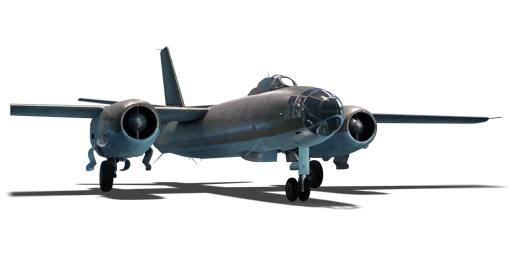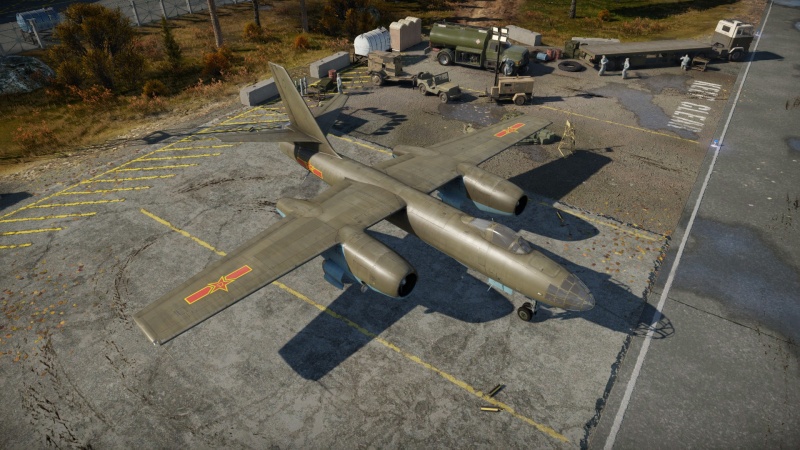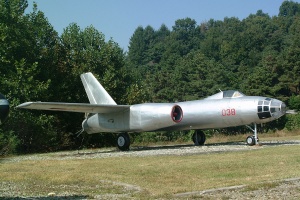Difference between revisions of "H-5"
TiMe_tO_FaiL (talk | contribs) m (→Pros and cons) (Tag: Visual edit) |
m (Unnecessary "IL-28" corrected to H-5) (Tag: Visual edit) |
||
| Line 198: | Line 198: | ||
<!-- ''Describe the tactics of playing in the aircraft, the features of using aircraft in a team and advice on tactics. Refrain from creating a "guide" - do not impose a single point of view, but instead, give the reader food for thought. Examine the most dangerous enemies and give recommendations on fighting them. If necessary, note the specifics of the game in different modes (AB, RB, SB).'' --> | <!-- ''Describe the tactics of playing in the aircraft, the features of using aircraft in a team and advice on tactics. Refrain from creating a "guide" - do not impose a single point of view, but instead, give the reader food for thought. Examine the most dangerous enemies and give recommendations on fighting them. If necessary, note the specifics of the game in different modes (AB, RB, SB).'' --> | ||
| − | The | + | The H-5 is an extremely versatile aircraft, thanks to its extensive suspended ordnance options. The aircraft can be used as a bomber, or as a CAS aircraft with its bombs. As well, the H-5 gets access to a powerful forward-firing and defensive set of 23 mm cannons. |
| − | Due to its impressive low-altitude manoeuvring capabilities (for a medium bomber), the | + | Due to its impressive low-altitude manoeuvring capabilities (for a medium bomber), the H-5 can be utilized in a variety of roles. In all game modes, if a teammate is struggling to evade an assailant, the H-5 may be able to provide the supporting fire with its dual 23 mm cannons. The aircraft is hampered in this role partly because of its mediocre roll rate and low ammunition count for its forward-firing cannons. If its bomb load is expended, the H-5 is also a very capable "gunship", or a bomber aircraft whose role is to attract, distract, and destroy enemy aircraft. Other aircraft that can perform this role include the [[G8N1|G8N1 Renzan]], [[IL-10 (1946)]], [[B-29A-BN|B-29 Superfortress]], and [[B-24D-25-CO|B-24D Liberator]], among others. |
| − | The | + | The H-5 can be used as a base-bomber in RB. This is initially difficult due to its small stock load of twelve 100 kg bombs, but becomes much easier once the 3,000 kg bomb is unlocked. This monster of a bomb is the second-largest bomb in the game, after the [[Pe-8]]'s [[FAB-5000 (5,000 kg)|FAB-5000]] bomb. This bomb can one-shot bases very easily. When used in this manner, proceed to the nearest base as fast as possible (possibly in a slight dive), drop ordnance, and run. This ensures that the H-5 won't be intercepted by any fighters, which will take more time to get there. Attempting to climb may not be the best option, as many enemy fighters can get to bomber altitude very quickly. |
| − | The second, and more interesting option for the | + | The second, and more interesting option for the H-5 is ground attack. The aircraft can carry a variety of powerful ground-attack ordnance (namely the aforementioned 3,000 kg bomb), which make the aircraft extremely effective in mixed battles. When used in this manner, it is worth noting that the aircraft is much more vulnerable, especially in air battles where enemy fighters will arrive extremely quickly. The first effective load for ground attack is the aforementioned 3,000 kg bomb; despite only having a single drop, the bomb is effective enough to take out every enemy tank at a base. This option also ensures the safety of the aircraft, as you will be able to escape quickly after dropping the bomb. |
| − | The | + | The H-5 shouldn't be used in an air-to-air role, as it will be outmanoeuvred and outspeeded by most fighters at its BR. If being pursued, employ evasive manoeuvres, and utilize the H-5's powerful tail gun to shoot at pursuing fighters. The tail turret, packing two NR-23 autocannons, is especially effective, and can easily destroy pursuing attackers. As well, the H-5 can encounter early missiles such as the [[AIM-9B Sidewinder|AIM-9B]]. If an enemy fires a missile at you, wait until the missile gets close, then perform a sharp manoeuvre. The early missile's weak seeker and G-force capability prevents it from tracking reliably. |
=== Pros and cons === | === Pros and cons === | ||
Revision as of 00:15, 25 June 2021
| This page is about the Chinese jet bomber H-5. For the Russian variant, see IL-28. |
Contents
Description
The H-5 is a rank V Chinese jet bomber with a battle rating of 8.0 (AB/RB/SB). It was introduced in Update 1.91 "Night Vision".
General info
Flight performance
| Characteristics | Max Speed (km/h at 4,500 m) |
Max altitude (metres) |
Turn time (seconds) |
Rate of climb (metres/second) |
Take-off run (metres) | |||
|---|---|---|---|---|---|---|---|---|
| AB | RB | AB | RB | AB | RB | |||
| Stock | 860 | 834 | 11500 | 49.4 | 50.3 | 16.4 | 15.5 | 1,480 |
| Upgraded | 953 | 905 | 46.7 | 48.0 | 24.0 | 20.0 | ||
Details
| Features | |||||
|---|---|---|---|---|---|
| Combat flaps | Take-off flaps | Landing flaps | Air brakes | Arrestor gear | Drogue chute |
| ✓ | ✓ | ✓ | X | X | X |
| Limits | ||||||
|---|---|---|---|---|---|---|
| Wings (km/h) | Gear (km/h) | Flaps (km/h) | Max Static G | |||
| Combat | Take-off | Landing | + | - | ||
| 0 | 400 | 577 | 548 | 400 | ~7 | ~4 |
| Optimal velocities (km/h) | |||
|---|---|---|---|
| Ailerons | Rudder | Elevators | Radiator |
| < 500 | < 600 | < 600 | N/A |
Engine performance
| Engine | Aircraft mass | |||||||
|---|---|---|---|---|---|---|---|---|
| Engine name | Number | Empty mass | Wing loading (full fuel, no boosters) | |||||
| Klimov VK-1 | 2 | 13,170 kg | 326 kg/m2 | |||||
| Engine characteristics | Mass with fuel (no weapons load, no boosters) | Max Takeoff Weight | ||||||
| Weight (each) | Type | 23m fuel | 30m fuel | 45m fuel | 60m fuel | 77m fuel | ||
| 872 kg | Centrifugal-flow turbojet | 15,172 kg | 15,772 kg | 17,058 kg | 18,344 kg | 19,801 kg | 23,200 kg | |
| Maximum engine thrust @ 0 m (RB / SB) | Thrust to weight ratio @ 0 m (100%, no boosters) | |||||||
| Condition | 100% | WEP | 23m fuel | 30m fuel | 45m fuel | 60m fuel | 77m fuel | MTOW |
| Stationary | 2,678 kgf | N/A | 0.35 | 0.34 | 0.31 | 0.29 | 0.27 | 0.23 |
| Optimal | 2,678 kgf (0 km/h) |
N/A | 0.35 | 0.34 | 0.31 | 0.29 | 0.27 | 0.23 |
| Booster (Solid fuel rocket) | Aircraft mass | |||||||||
|---|---|---|---|---|---|---|---|---|---|---|
| Number | Booster weight (each) |
Fuel weight (each) |
Burn Time |
Can be shutdown |
Jettisoned after use |
Mass with full booster fuel (no weapons load) | ||||
| 23m fuel | 30m fuel | 45m fuel | 60m fuel | 77m fuel | ||||||
| 2 | 50 kg | 190 kg | 13s | No | Yes | 15,652 kg | 16,202 kg | 17,538 kg | 18,824 kg | 20,281 kg |
| Condition | Maximum booster thrust @ 0 m (RB / SB) |
Combined engine & booster thrust @ 0 m |
Thrust to weight ratio @ 0 m (100% with booster) | |||||||
| 23m fuel | 30m fuel | 45m fuel | 60m fuel | 77m fuel | ||||||
| Stationary | 1,682 kgf | 8,720 kgf | 0.56 | 0.54 | 0.50 | 0.46 | 0.43 | |||
| Optimal | 1,682 kgf (any speed) |
8,720 kgf (0kph) |
0.56 | 0.54 | 0.50 | 0.46 | 0.43 | |||
Survivability and armour
- Armour plates
Front gunner
- 6 mm steel plate for the front gunner's seat.
- 10 mm (bottom) and 32 mm (top) steel plates behind the front gunner.
- 10 mm steel plate under the nose.
Pilot
- 6 mm steel plate for the pilot's seat.
- 10 mm steel plate behind the pilot.
- 32 mm (top) steel plate in front of the pilot (part of the steel plate behind the front gunner).
Tail gunner
- 10 mm steel plate under the tail gunner.
- 8 mm steel plates in front of tail gunner.
- 102 mm (rear) and 68 mm (sides) bulletproof glass panes in front of tail gunner.
Modifications and economy
Armaments
Offensive armament
The H-5 is armed with:
- 2 x 23 mm NR-23 cannons, nose-mounted (100 rpg = 200 total)
Suspended armament
The H-5 can be outfitted with the following ordnance:
- 12 x 100 kg FAB-100M-43 bombs (1,200 kg total)
- 8 x 250 kg FAB-250M-46 bombs (2,000 kg total)
- 4 x 500 kg FAB-500M-46 bombs (2,000 kg total)
- 1 x 1,500 kg FAB-1500M-46 bomb (1,500 kg total)
- 1 x 3,000 kg FAB-3000M-46 bomb (3,000 kg total)
Defensive armament
The H-5 is defended by:
- 2 x 23 mm NR-23 cannons, tail turret (225 rpg = 450 total)
Usage in battles
The H-5 is an extremely versatile aircraft, thanks to its extensive suspended ordnance options. The aircraft can be used as a bomber, or as a CAS aircraft with its bombs. As well, the H-5 gets access to a powerful forward-firing and defensive set of 23 mm cannons.
Due to its impressive low-altitude manoeuvring capabilities (for a medium bomber), the H-5 can be utilized in a variety of roles. In all game modes, if a teammate is struggling to evade an assailant, the H-5 may be able to provide the supporting fire with its dual 23 mm cannons. The aircraft is hampered in this role partly because of its mediocre roll rate and low ammunition count for its forward-firing cannons. If its bomb load is expended, the H-5 is also a very capable "gunship", or a bomber aircraft whose role is to attract, distract, and destroy enemy aircraft. Other aircraft that can perform this role include the G8N1 Renzan, IL-10 (1946), B-29 Superfortress, and B-24D Liberator, among others.
The H-5 can be used as a base-bomber in RB. This is initially difficult due to its small stock load of twelve 100 kg bombs, but becomes much easier once the 3,000 kg bomb is unlocked. This monster of a bomb is the second-largest bomb in the game, after the Pe-8's FAB-5000 bomb. This bomb can one-shot bases very easily. When used in this manner, proceed to the nearest base as fast as possible (possibly in a slight dive), drop ordnance, and run. This ensures that the H-5 won't be intercepted by any fighters, which will take more time to get there. Attempting to climb may not be the best option, as many enemy fighters can get to bomber altitude very quickly.
The second, and more interesting option for the H-5 is ground attack. The aircraft can carry a variety of powerful ground-attack ordnance (namely the aforementioned 3,000 kg bomb), which make the aircraft extremely effective in mixed battles. When used in this manner, it is worth noting that the aircraft is much more vulnerable, especially in air battles where enemy fighters will arrive extremely quickly. The first effective load for ground attack is the aforementioned 3,000 kg bomb; despite only having a single drop, the bomb is effective enough to take out every enemy tank at a base. This option also ensures the safety of the aircraft, as you will be able to escape quickly after dropping the bomb.
The H-5 shouldn't be used in an air-to-air role, as it will be outmanoeuvred and outspeeded by most fighters at its BR. If being pursued, employ evasive manoeuvres, and utilize the H-5's powerful tail gun to shoot at pursuing fighters. The tail turret, packing two NR-23 autocannons, is especially effective, and can easily destroy pursuing attackers. As well, the H-5 can encounter early missiles such as the AIM-9B. If an enemy fires a missile at you, wait until the missile gets close, then perform a sharp manoeuvre. The early missile's weak seeker and G-force capability prevents it from tracking reliably.
Pros and cons
Pros:
- Powerful rear 23 mm cannon turret
- Very fast - many early jet fighters cannot catch it at top speed
- Powerful and flexible ordnance capacity
- Highly armoured tail gunner position
- Gunner can cover a large area of the rear and the sides because of the turret design
- Good acceleration
- Tricycle landing gears allow easy braking once landed
Cons:
- Fuel tanks are not protected by any armour
- Fairly small payload compared to its counterparts
- Able to be intercepted by Korean War-era jet aircraft
- Poor roll rate; any wing damage will often result in a roll that is impossible to pull out of
- Cockpit features no rear visibility
- Fast acceleration means that you might break the wings if you don't pay attention
History
The Harbin H-5 was the Chinese-produced version of the IL-28 'Beagle', a Soviet-designed light bomber used by a variety of countries in the Soviet Bloc.[1] Initially entering service in 1967,[2] the aircraft had several changes compared to the original IL-28 including redesigns of the wing and tail structure. Multiple variants of the H-5 were developed, including nuclear weapon carriers, electronic warfare aircraft and reconnaissance aircraft.[2] The last bomber-variant H-5s were retired in the early 1990s, though it is speculated that some airframes are still in use today in secondary duties.[1]
Development and construction
In the 1950s, China received several IL-28 'Beagle' jet bombers from the Soviet Union. These aircraft proved to be highly useful, and were used against the Taiwanese in the First Taiwan crisis of 1954-55.[1] However, the Soviets did not give the Chinese a license for production. As a result, the Chinese government ordered the Harbin aircraft production plant to produce the IL-28 without a license, based on existing Chinese IL-28 aircraft. The aircraft featured numerous changes, the most notable being a redesign of the wing and tail structural panels.[1] As well, later H-5 aircraft were equipped with a modernised turret carrying two AM-23 autocannons with a greatly improved fire rate, though this feature is not included in-game.[1]
The production of the H-5 was hampered by the cultural revolution, and though an initial prototype flew in 1962,[2] mass production didn't commence until the late 1960s. After entering service, the H-5 became a primary frontline bomber of the PLAAF.
Operational History
The Harbin H-5 entered full-scale production in mid-1967,[1] and began entering service with PLAAF bomber units. However, it had become relatively obsolete by the time it entered service, mainly due to its lack of advanced avionics which effectively limited it to daylight missions. Nevertheless, a range of H-5 models were developed. This included the H-5A, a variant of the H-5 designed specifically to carry nuclear weapons.[1] This variant would drop a nuclear bomb during a test, in 1968. Other variants include the HZ-5 reconnaissance variant, HD-5 electronic warfare variant, and the HJ-5 bomber trainer.[1][2]
The H-5 was used extensively by Chinese frontline units and was retired from frontline service in 1990, well after the retirement of the Soviet IL-28.[1] There are reports of H-5 variants still in service, but the official PLAAF consensus is that the H-5 was completely retired by 1990. As well, the H-5 was used in a successful defection attempt, by a Chinese captain who flew his airplane to Taiwan.[1] This aircraft was the first operational IL-28 type aircraft recovered by the west.[1]
Media
Excellent additions to the article would be video guides, screenshots from the game, and photos.
See also
Links to the articles on the War Thunder Wiki that you think will be useful for the reader, for example:
- reference to the series of the aircraft;
- links to approximate analogues of other nations and research trees.
External links
References
Works Cited
- Eastern Order of Battle. (n.d.). Harbin H-5. Retrieved November 23, 2020, from http://www.easternorbat.com/html/harbin_h-5_eng.html
- Aguilera, R. (1997). Harbin H-5 'Beagle'. Retrieved November 23, 2020, from http://www.theworldwars.net/weapons/entry.php?b=air
| Harbin Aircraft Manufacturing Corporation (哈尔滨飞机工业(集团)有限责任公司 ) | |
|---|---|
| Jet Bombers | H-5* |
| Helicopters | |
| Z-9 | Z-9W · Z-9WA |
| Z-19 | Z-19 · Z-19E |
| *Unlicensed and modified copy of the IL-28. | |
| China jet aircraft | |
|---|---|
| Fighters | J-2 · J-4 · J-6A · J-7II · J-7D · J-7E · J-8B · J-8F · J-10A · J-11 · J-11A |
| Strike aircraft | Q-5 early · Q-5A · Q-5L · JH-7A |
| Bombers | H-5 |
| France | ␗Mirage 2000-5Ei |
| USA | ␗F-84G-21-RE · ␗F-84G-31-RE · ␗F-86F-30 · ␗F-86F-40 · ␗F-100A · ␗F-100F · ␗F-104A · ␗F-104G · ␗F-5A · ␗F-5E · ␗F-16A MLU |
| USSR | ␗MiG-9 · ␗MiG-9 (l) |
| North Korea | Shenyang F-5 |
| Pakistan | A-5C · JF-17 |






